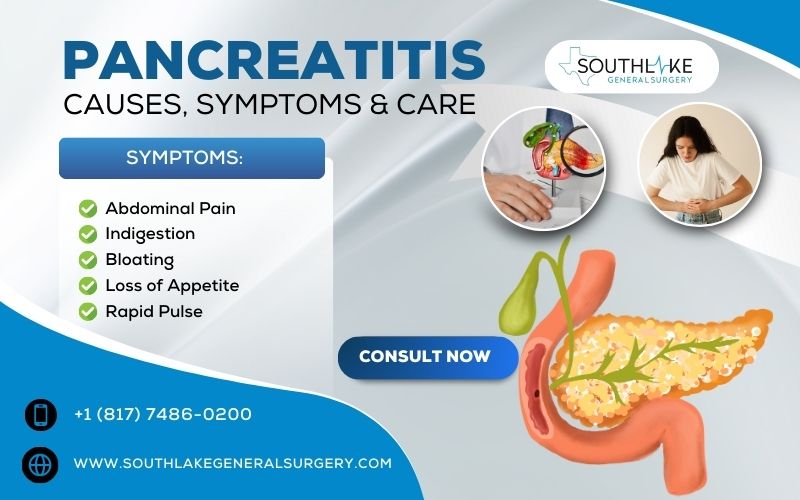Pancreatitis refers to the inflammatory condition affecting the pancreas. It’s usually short-term but can also persist over a long duration. Abdominal pain is the symptom that is most commonly reported. The primary factors contributing to this condition are the consumption of alcohol and the presence of gallstones.
Key Highlights
- Pancreatitis refers to the swelling or inflammation of the pancreas, an essential organ responsible for generating digestive fluids and hormones such as insulin.
- The primary symptom is abdominal pain, which can range from mild to severe.
- Common causes include gallstones and excessive alcohol use.
- Treatment focuses on resting the pancreas, managing pain, and addressing underlying causes.
- Lifestyle modifications, including diet changes and alcohol cessation, are significant in managing the condition.
What is Pancreatitis?
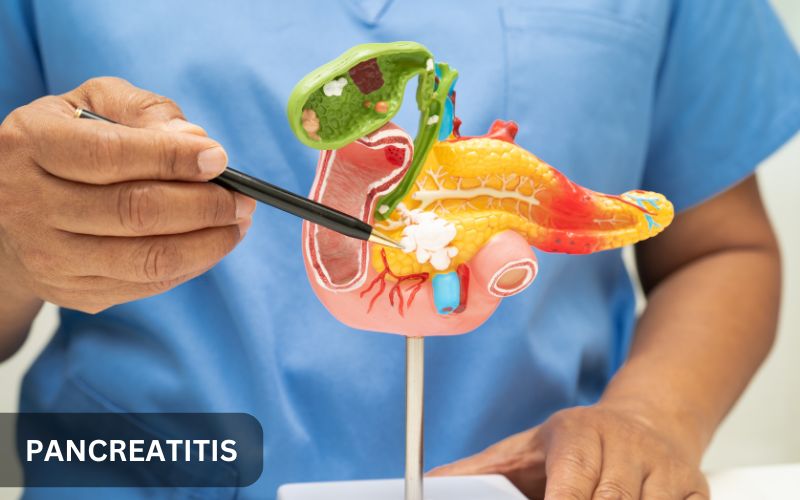
Pancreatitis refers to the condition in which the pancreas experiences inflammation. This inflammation leads to swelling and pain. If you experience pancreatitis, you may notice abdominal pain that radiates to your back.
Your pancreas is a small organ located in the abdomen region. The pancreas helps by making digestive juices that break down food in the small intestine. It also helps control blood sugar levels by producing insulin.
When the pancreas experiences inflammation, the digestive enzymes might not be able to reach the small intestine. Rather, they may provoke irritation in the pancreas, leading to pain and potential damage.
Inflammation signifies the immune system’s response to damage or injury. It is designed to assist in the recovery of damaged tissues. Pancreatic injury usually happens due to gallstones obstructing the pancreatic duct or because of alcohol consumption.
Pancreatitis can be classified into two categories: acute and chronic. Every category possesses its own indicators and impacts.
Acute vs. Chronic Pancreatitis: Knowing the Difference
Pancreatitis is a medical condition that can be categorized into two primary forms: acute pancreatitis and chronic pancreatitis.
Acute Pancreatitis
Acute pancreatitis occurs when there is a sudden inflammation of the pancreas. This usually persists for a short time and may lead to temporary problems within the digestive system. This occurs when the pancreas is attempting to heal from a minor or temporary injury or damage.
Many people with this condition completely recover in a few days with the help of supportive care such as proper rest, hydration, and pain management. However, people with complex cases of acute pancreatitis can experience significant health problems, some of which may be life-threatening.
Key points of Acute Pancreatitis
- Sudden Onset: Rapid development.
- Short-Term: Typically resolves within days or weeks.
- Inflammation: Severe, localized.
- Causes: Gallstones, alcohol, trauma, infections.
- Symptoms: Severe abdominal pain, nausea, vomiting.
Chronic Pancreatitis
Chronic pancreatitis is a persistent long-term condition characterized by ongoing inflammation of the pancreas. It doesn’t heal on its own and can get worse and intensify as time progresses.
Chronic pancreatitis can lead to long-term damage to your pancreas, but it’s important to note that this process may take many years to develop.
Ongoing inflammation can lead to scarring in the tissues of your pancreas, a condition known as fibrosis. This scarring can interfere with the pancreas’s ability to produce essential enzymes and hormones.
The key point of Chronic Pancreatitis
- Gradual Onset: Progressive development.
- Long-Term: Persistent, ongoing inflammation.
- Fibrosis: Scarring, tissue damage.
- Causes: Alcohol abuse, genetic predisposition, autoimmune disorders.
- Symptoms: Recurring abdominal pain, weight loss, diarrhea.
Is Pancreatitis Common?
In the United States, pancreatitis is one of the major health concerns that people experience, affecting many individuals annually. Over 275,000 hospitalizations occur each year due to acute pancreatitis, with around 86,000 Americans impacted by chronic pancreatitis.
Symptoms and Causes of Pancreatitis

Identifying pancreatitis symptoms
Pancreatitis is characterized by pain in the upper abdominal region, often described as a persistent ache that can extend to the back.
Acute pancreatitis can present a range of symptoms in addition to intense abdominal pain, nausea, and vomiting. Additional symptoms may include:
- Fever
- Rapid pulse
- Nausea
- Vomiting
- Bloating
- Jaundice
Patients with acute pancreatitis might also experience:
- Loss of appetite
- Unexplained weight loss
- Stools that appear oily or greasy, may indicate challenges with fat digestion
It’s essential to seek immediate medical attention if you experience these symptoms as acute pancreatitis can be life-threatening if left untreated.
Chronic pancreatitis is a medical condition identified by persistent inflammation of the pancreas that progressively deteriorates over time. Additional symptoms of chronic pancreatitis include:
- Abdominal pain that persists can range from mild to severe and may also radiate to the back.
- Pain that increases after consuming food or beverages, particularly those rich in fat
- Unintentional weight loss
- Oily and foul-smelling stools (steatorrhea)
- Dizziness due to lower blood pressure.
- Bloating
- Indigestion
In advanced stages of chronic pancreatitis, individuals may experience diabetes due to the damage to insulin-producing cells in the pancreas. This may result in symptoms like:
- Increased thirst
- Frequent urination
- Fatigue
- Blurred vision.
How does the discomfort of pancreatitis feel?
Abdominal pain due to pancreatitis is usually steady and strong that may extend to your back. This pain tends to get worse after eating, especially after consuming fatty foods, or when lying flat on your back. Often, the pain starts in the upper abdomen, right below the ribs. It can spread to the back, left shoulder blade, or chest.
- Acute pancreatitis brings sudden and severe, penetrating pain. When you touch your abdomen, you can feel some tenderness.
- Chronic pancreatitis may cause pain that changes in strength. Some people feel constant pain, while others have pain that comes and goes, getting worse over time.
Pancreatitis pain can make it hard to carry out daily activities and affect your quality of life. It often becomes more intense after meals, with alcohol consumption, or when lying down.
It’s important to find effective ways to manage pain to improve comfort and help people keep their daily routines.
What symptoms indicate pancreas dysfunction?
When the pancreas is not working well, it makes it hard for the digestive system to break down food and take in nutrients. This can lead to issues like:
- Diarrhea
- Fatty stools
- Weight loss
- Not getting enough nutrients
If food is not digested properly, a person may lose a lot of weight, even if they eat the same amount. You may also struggle to add some extra pounds to your weight, even with a good appetite. This indicates that the pancreas is not functioning properly.
Also, if the pancreas can’t help control blood sugar, it may lead to diabetes Symptoms such as
- Excessive thirst
- Frequent urination
- Losing weight without trying
- Feeling extra hungry
All these factors point to issues with blood sugar control and suggest that the pancreas may not be operating effectively.
Exploring the Most Common Causes of Pancreatitis
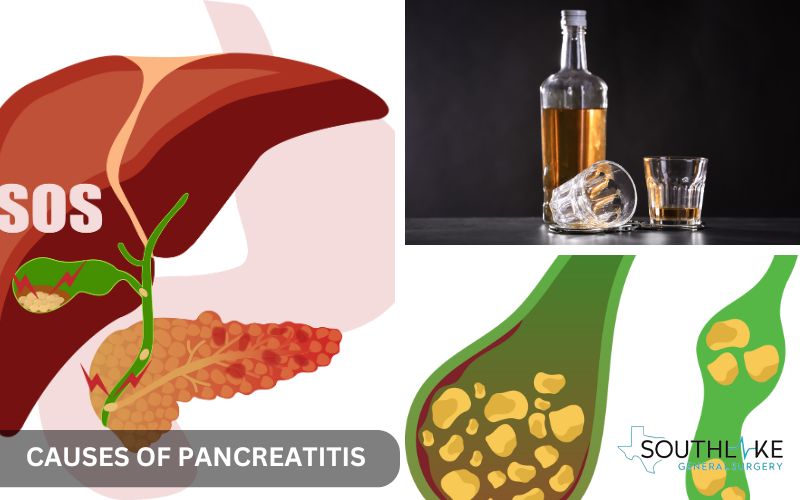
Pancreatitis is usually triggered by the presence of gallstones or heavy alcohol use. Together, these two factors contribute to around 80% of pancreatitis cases.
Gallstone Pancreatitis
The common bile duct facilitates the flow of bile from the gallbladder into the intestine, sharing the same entry point as the pancreatic duct. When a gallstone lodges in the common bile duct at the junction, it can create a temporary obstruction, preventing the flow of pancreatic juice from the pancreatic duct.
This confines the enzymes within your pancreas. As tension accumulates behind the blockage, it triggers the enzymes within your pancreas, leading to the digestion of the pancreas itself. This triggers the inflammatory reaction associated with gallstone pancreatitis.
Use of Alcohol
Heavy alcohol consumption is a significant risk factor for pancreatitis, causing inflammation and damage to the pancreas, yet the exact mechanisms remain unclear to researchers.
The harmful byproducts of alcohol in your bloodstream might trigger an inflammatory reaction in your pancreas, or they could potentially chemically stimulate the digestive enzymes present within your pancreas.
Researchers suggest that significant consumption of alcohol is responsible for approximately fifty percent of instances of both acute and chronic pancreatitis.
Other Causes of Pancreatitis
Gallstones and drinking too much alcohol are the main causes of pancreatitis. However, there are other reasons that can cause inflammation, including:
- Genetic disorders like cystic fibrosis, which affects the body’s mucus production, including in the pancreas
- Some medications can also cause drug-induced pancreatitis, even if they are helpful for other health issues
- Very high levels of triglycerides (hypertriglyceridemia) in the blood can trigger pancreatitis too
- Hypercalcemia (High blood calcium levels)
- Belly injuries
- Cancer
- Certain viral infections
- Structural problems in the pancreas
- Autoimmune disorders arise when the immune system erroneously identifies the pancreas as a target
These factors together account for approximately 20% of pancreatitis conditions. Sometimes, a reason remains difficult to identify.
Are the causes of acute and chronic pancreatitis identical?
The reasons for acute and chronic pancreatitis are alike in some ways, but they are different in others. Gallstones and drinking too much alcohol are common causes of both types. However, chronic pancreatitis can occur from lasting inflammation. Knowing these details is important for proper diagnosis and treatment.
Is Pancreatitis a Life-threatening Disease?
People with pancreatitis can face life-threatening complications and, in some cases, it can lead to death. It has been observed among a few individuals that severe acute pancreatitis triggers a systemic response that impacts the entire body. This results in severe complications and systemic failure, potentially leading to death if not addressed promptly.
If you’re experiencing symptoms, it’s important to seek immediate medical attention, as it can be difficult to assess the severity of your pancreatitis on your own.
What are the potential complications of pancreatitis?
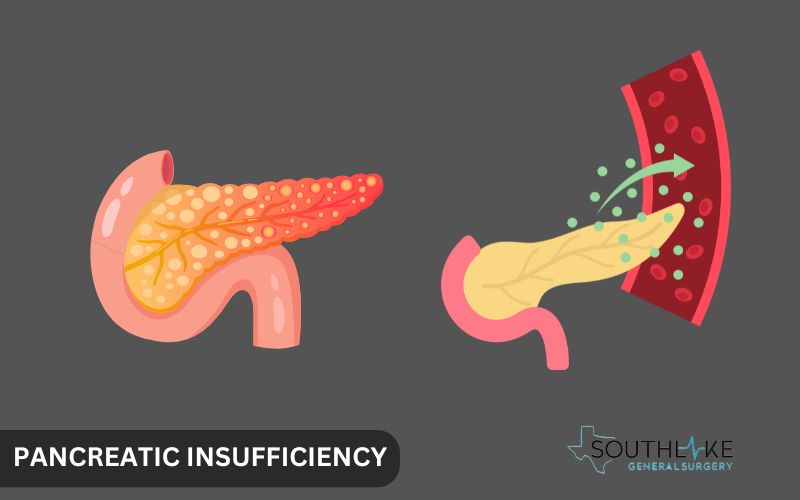
In many instances, acute pancreatitis remains uncomplicated; however, approximately 20% of cases are present with increased severity. The reasons behind the occurrence of severe acute pancreatitis in certain instances remain unclear.
A critical situation may result in significant consequences, potentially leading to fatal outcomes. Chronic pancreatitis leads to complications that progress gradually and are not immediately life-threatening. Most issues can be addressed effectively with appropriate treatment.
Acute Pancreatitis Complications
Severe acute pancreatitis can lead to a range of complications that can be life-threatening if not managed promptly. Some of the potential complications include:
- Pancreatic necrosis: In severe cases, the pancreatic tissue can become necrotic (dead), which can lead to infection and the development of abscess.
- Acute respiratory distress syndrome (ARDS): This condition may arise from the systemic inflammatory response linked to severe pancreatitis, leading to challenges in breathing.
- Multiple organ failure: Severe acute pancreatitis can initiate a series of reactions that impact various organs, including the kidneys, lungs, and heart, resulting in dysfunction across multiple systems.
- Pancreatic pseudocyst: This fluid-filled sac can develop within or around the due to inflammation and tissue damage.
- Diabetes mellitus: It occurs when there is damage to the pancreatic cells responsible for insulin production, which can happen after a severe case of acute pancreatitis.
- Malnutrition: A deficiency in digestive enzymes due to pancreatic damage can result in the improper absorption of nutrients, leading to malnutrition.
- Ascites: Fluid accumulation in the abdominal cavity may occur due to inflammation and disruption of normal fluid balance.
Chronic Pancreatitis Complications
Chronic pancreatitis, characterized by ongoing inflammation of the pancreas, can lead to multiple complications that significantly impact an individual’s health and overall quality of life. Some common complications associated with chronic pancreatitis include:
- Pancreatic Insufficiency: Inflammation in the pancreas can reduce enzyme production, causing malabsorption of nutrients. This results in a reduction in body weight, inadequate nutrition, and a lack of essential vitamins and minerals.
- Diabetes: Chronic pancreatitis can damage the cells responsible for insulin production, increasing the possibility of developing diabetes. Maintaining blood glucose levels can be difficult for individuals facing both conditions.
- Pancreatic Pseudocysts: Pseudocysts are fluid-filled cavities that may develop adjacent to the pancreas because of inflammation and tissue injury. If left unaddressed, they could result in discomfort in the abdomen, feelings of nausea, episodes of vomiting, and potential infections.
- Pancreatic Cancer: Extended inflammation and changes in pancreatic cells due to chronic pancreatitis elevate your risk of developing pancreatic cancer. Regular monitoring is essential for early detection and treatment.
- Pancreatic Ductal Strictures: Scar tissue in the pancreatic ducts can cause narrowing and blockages, leading to pain, digestive problems, and potential complications.
- Maldigestion: The insufficient generation of digestive enzymes due to pancreatic insufficiency can result in maldigestion, which may manifest as symptoms like bloating, diarrhea, fatty stools, and nutritional deficiencies.
- Pain Syndromes: Chronic abdominal pain often occurs in individuals with chronic pancreatitis, leading to significant discomfort that can severely affect everyday activities and overall quality of life.
- Exocrine Pancreatic Insufficiency (EPI): In advanced chronic pancreatitis stages, the insufficient production of pancreatic enzymes can result in exocrine pancreatic insufficiency (EPI), causing malabsorption, weight loss, and deficiencies in essential nutrients.
- Calcifications: Calcification within pancreatic tissue can occur due to extended inflammation, which may cause further dysfunction and complications.
Diagnosing Pancreatitis: Essential Tests and Procedures
How to Diagnose Pancreatitis?
To diagnose pancreatitis, your healthcare provider may recommend a combination of blood tests and imaging tests.
Initial Diagnostic Steps:
- Pancreas blood test: Evaluates levels of enzymes produced by the pancreas (such as amylase and lipase).
- Values exceeding levels 3+ times normally indicate pancreatitis.
- Cross-sectional imaging: CT scan or MRI to visualize pancreatic swelling, fluid deposits, and abnormalities.
Additional Tests for Chronic Pancreatitis:
- Glucose test: To determine if your pancreas continues to produce insulin efficiently.
- Stool elastase test: To evaluate if your pancreas is producing sufficient digestive enzymes.
- Fecal fat analysis: It detects excess fat in your stool, indicating malabsorption.
- Blood tests: To measure the nutritional status, and fat-soluble vitamin levels in our body.
Treatment and Management for Pancreatitis
What types of treatments are available for pancreatitis?
The approach for treatment is contingent upon the underlying factor, its duration, and the level of severity involved. It is advisable to consult a healthcare professional if you experience symptoms indicative of pancreatitis.
While certain instances of acute pancreatitis might resolve spontaneously, this is based on the underlying cause and the severity of the condition. During this period, individuals experiencing acute pancreatitis typically require pain relief to manage their discomfort.
Certain individuals may require immediate support for specific reasons. Additionally, certain individuals may require specialized attention due to complications.
Acute Pancreatitis Treatment
The treatment for acute pancreatitis usually involves hospitalization. This includes close observation, and medical assistance, which is necessary for every individual. Your doctor will primarily focus on minimizing stress on the pancreas, controlling pain, and ensuring adequate hydration.
Certain individuals might require admission to an intensive care unit (ICU) for close monitoring, particularly in cases of serious health issues.
- Maintaining proper hydration is essential. This can often be done through an IV that helps with blood flow and the functionality of organs.
- Pain relief is an essential component of the treatment strategy. Strong pain relievers are administered via intravenous infusion to ensure rapid relief from discomfort.
Other actions may include:
- Placing a nasogastric tube to assist in the evacuation of fluid or air from the gastric cavity.
- Administering nutrition through IV feeding when oral intake is not possible.
- Giving antibiotics in the presence of an infection.
- Removal of gallstones obstructing the path for individuals experiencing gallstone pancreatitis.
Gallstones Removal
If you are experiencing gallstone pancreatitis, your healthcare provider might require the removal of gallstones from your bile ducts. They may suggest gallbladder removal surgery (cholecystectomy) to prevent potential complications from gallstones in the future.
Endoscopic retrograde cholangiopancreatography, or ERCP includes:
- ERCP uses a long, flexible tube with a camera and small tools.
- The physician carefully places this tube through the mouth, guiding it down the esophagus, into the stomach, and then into the small intestine.
- This helps them see the bile duct and take out gallstones that are blocking it.
- This procedure helps to reduce pressure on the pancreas.
Gallbladder Removal Surgery:
To avoid any future complications, your doctor will perform gallbladder removal surgery, since the possibility of the formation of gallstones is quite high.
Gallbladder removal is a common procedure for the treatment of gallstones. Your doctor will guide you and suggest the surgical procedures. The options available are laparoscopic gallbladder removal surgery or open surgery.
A laparoscopic cholecystectomy also known as minimally invasive surgery involves the extraction of the gallbladder through a few small incisions, utilizing a laparoscope, with a miniature camera introduced through one of the openings.
Certain individuals might need to undergo traditional surgical procedures based on their specific medical conditions.
Additional Support for Pancreatitis
Pancreatitis is a significant medical issue. A notable complication is the presence of pseudocysts, which are fluid-filled sacs located within the pancreas. Pseudocysts can lead to pain, feelings of nausea, and episodes of vomiting, and may result in infections that occasionally require drainage or surgery.
Another concern is pancreatic necrosis, which involves the death of tissue due to inflammation. This may result in infections, abscesses, and potential organ failure. The approach includes the use of antibiotics, surgical procedures, and methods to eliminate necrotic tissue.
Chronic pancreatitis can lead to diabetes. Damage to insulin-producing cells requires managing blood sugar with medication, diet, and lifestyle changes.
In more serious situations, there is a possibility of developing systemic complications such as sepsis. Getting prompt medical attention and treatment is essential for achieving better outcomes.
Consistent follow-up care and adherence to treatment plans play a crucial role in managing and lowering the risks associated with this condition.
Chronic Pancreatitis Treatment
Chronic pancreatitis is a long-lasting condition. It requires a careful plan to manage symptoms, slow down the disease, and handle problems that may arise. This plan usually includes changes in lifestyle, medications, and sometimes surgery.
- Enzyme replacement therapy: This approach is crucial for addressing digestive challenges resulting from insufficient enzyme production by the pancreas. These enzyme supplements are consumed along with meals to facilitate the breakdown of food, enhance nutrient absorption, reduce digestive pain, and prevent malnutrition.
- Blood sugar management: It is crucial for preventing diabetes, as chronic pancreatitis can lead to this condition. Insulin therapy might be needed if diet and lifestyle changes are not enough to keep sugar levels stable.
- Pain management: It involves using pain relievers, nerve blocks, and alternative methods like acupuncture to help with chronic pain.
Lifestyle Changes
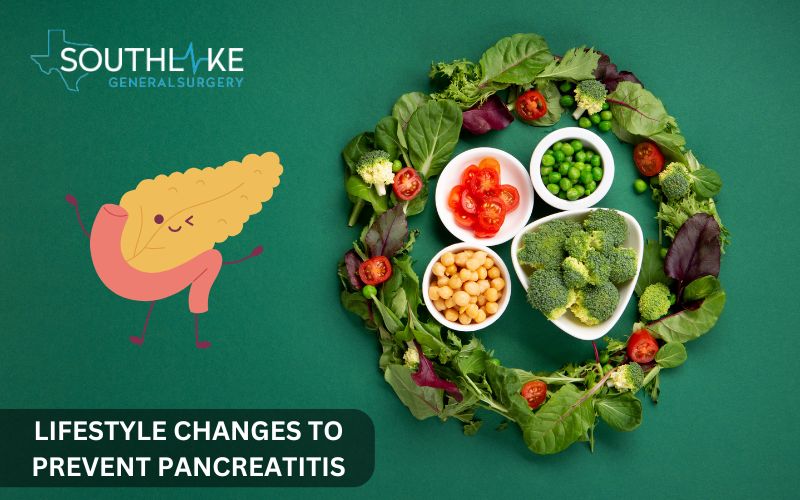
By making some yet powerful lifestyle changes can help you manage both acute and chronic pancreatitis. These tweaks will help you to reduce stress on your pancreas, lower inflammation, and boost your overall well-being.
1. Maintain Optimal Health with a Balanced Diet
A low-fat diet rich in whole foods is key. Focus on:
- Fresh fruits and vegetables
- Lean proteins
- Whole grains
You should avoid fatty, greasy foods that can overload your pancreas and exacerbate inflammation.
2. Break Free from Alcohol
If alcohol contributes to your condition, it’s essential to abstain. Alcohol can further irritate your pancreas, slowing healing.
3. Breathe Easy: Quit Smoking
Smoking can worsen pancreatic damage and increase cancer risk. For your general health, quitting is essential.
By incorporating these lifestyle changes, you’ll:
- Reduce pancreatitis symptoms
- Lower inflammation
- Improve digestion
- Enhance overall health
The influence of these factors significantly accelerates the development of pancreatitis. Your healthcare provider can link you to resources that assist in discontinuation. Let’s team up to create a customized strategy that aligns with your specific requirements.
Pain Management
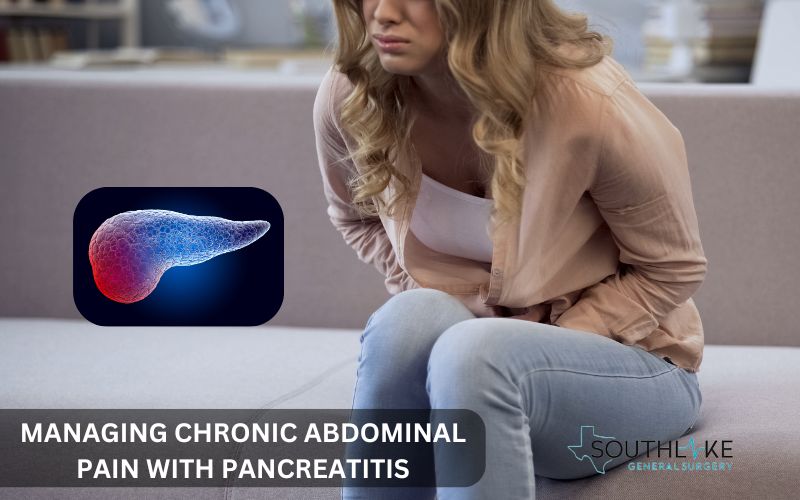
Managing chronic pain can be a challenging journey. Every individual’s experience with pain is different, and it might require some experimentation to find the most effective solutions for your needs.
Be open with your healthcare provider about your pain to explore options and find the right combination that brings you relief, which includes:
- Medications tailored to your needs
- Endoscopic procedures to remove scar tissue or stones
- Celiac plexus block injections for targeted relief
Stay connected with your provider to adjust your plan as needed. They might also direct you to a specialist in chronic pain management. Don’t settle for unmanaged pain – take control and find relief.
Supplements to Support Treatment
To enhance your treatment plan, supplements can be a game changer! People experiencing chronic pancreatitis may face challenges in absorbing essential nutrients. Here’s what you need to know:
To manage symptoms and support digestive health, your healthcare provider may recommend:
- Pancreatic enzyme supplements
- Nutritional supplements for vital calories, vitamins, and minerals
Some individuals may experience a decline in their ability to process glucose, potentially leading to diabetes and requiring insulin for management. Consult your healthcare provider to identify the most suitable supplement strategy tailored to your needs.
Surgical Options
If significant inflammation is localized in a particular section of your pancreas and that area is leading to unbearable pain or complications, your healthcare provider may recommend surgical intervention to remove that portion of your pancreas (resection).
In highly complex situations, where the pancreas has sustained considerable damage and continues to produce intense pain, a complete removal of the pancreas (total pancreatectomy) may be advised.
Preventive Measures Against Pancreatitis
How do I stay safe from pancreatitis?
To protect yourself against this condition, it is essential to make thoughtful decisions regarding your lifestyle. Here are several proactive strategies:
- Eat a balanced diet with low levels of saturated and trans fats, cholesterol, and refined sugars
- Avoid excessive alcohol intake, especially if you have a history of pancreatitis
- Make sure to incorporate a variety of fruits, vegetables, whole grains, and lean proteins into your meals
- Visit your doctor for regular checkups to spot any risk factors and manage other health issues
Conclusion
What is the long-term prognosis for pancreatitis?
Many individuals experience full recovery from acute pancreatitis. If the situation isn’t critical, you can expect to feel improvement within five to ten days. In instances of significant or intricate conditions, an extended hospital stay of several weeks may be necessary.
If you could stay away from the factors that led to your acute pancreatitis in the future, it’s likely that it won’t happen again. A limited percentage of people experiencing organ failure exhibit a mortality rate of 20%.
Chronic pancreatitis develops gradually over time. By maintaining consistent attention, you can monitor its development and proactively address any potential issues. Managing pain can pose difficulties for certain individuals, and it may also impact mental well-being and overall quality of life.
In such situations, surgical intervention could be considered. It is possible to survive without your pancreas, though this condition may lead to a reliance on insulin.
Make an Appointment
Are you concerned about pancreatitis? Don’t hesitate!
You can consult Dr. Valeria Simone, MD, a renowned board-certified general surgeon and expert in pancreatic care at Southlake General Surgery in Texas, USA. With compassion and expertise, Dr. Simone will:
- Address your symptoms and concerns
- Create a personalized treatment plan
- Support you throughout the entire process
Ready to manage your pancreatitis? Schedule an appointment today! Contact our healthcare expert at +1 (817) 748-0200.
Connect with our healthcare team to start your journey towards better pancreatic health.
Your care is our priority! Dr. Simone and her team look forward to helping you. Book your appointment now!
Frequently Asked Questions
Can Pancreatitis Become Life-Threatening?
Pancreatitis is often mild, but it can be very serious in severe cases. Some complications, like organ failure, might need intensive care. Sadly, death is a possible result in these situations. Acting early can greatly improve the chances of successful treatment.
How Can Diet Influence Pancreatitis?
A diet full of fatty foods can cause pancreatitis or make current problems worse. Changing your diet is very important for handling pancreatitis. This approach focuses on good nutrition and reduces stress on the pancreas.
Are There Effective Ways to Manage Pancreatitis Pain at Home?
Yes. A combination of over-the-counter pain relief methods and lifestyle changes can help you manage pancreatitis pain at home. You can also include a low-fat diet and stay hydrated. However, talking to your doctor for personal advice and support on pain management strategies is always recommended.
Medically Reviewed By: Dr. Valeria Simone MD
Board-certified General Surgeon at Southlake General Surgery, Texas, USA.
Follow us on Facebook and YouTube.
References:
- National Library of Medicine. (n.d.). Pancreatitis. MedlinePlus. https://medlineplus.gov/pancreatitis.html
- Pancreatitis – NIDDK. (n.d.). National Institute of Diabetes and Digestive and Kidney Diseases. https://www.niddk.nih.gov/health-information/digestive-diseases/pancreatitis
- Gapp, J., Tariq, A., & Chandra, S. (2023, February 9). Acute Pancreatitis. StatPearls – NCBI Bookshelf. https://www.ncbi.nlm.nih.gov/books/NBK482468/
- Acute pan: MedlinePlus Medical Encyclopedia. (n.d.). https://medlineplus.gov/ency/article/000287.htm
- Chronic pa: MedlinePlus Medical Encyclopedia. (n.d.). https://medlineplus.gov/ency/article/000221.htm
- Singh VK, Yadav D, Garg PK. Diagnosis and Management of Chronic pan: A Review. JAMA. 2019 Dec 24;322(24):2422-2434. doi: 10.1001/jama.2019.19411. PMID: 31860051.
- Gardner TB, Adler DG, Forsmark CE, Sauer BG, Taylor JR, Whitcomb DC. ACG Clinical Guideline: Am J Gastroenterol. 2020 Mar;115(3):322-339. doi: 10.14309/ajg.0000000000000535. PMID: 32022720.

